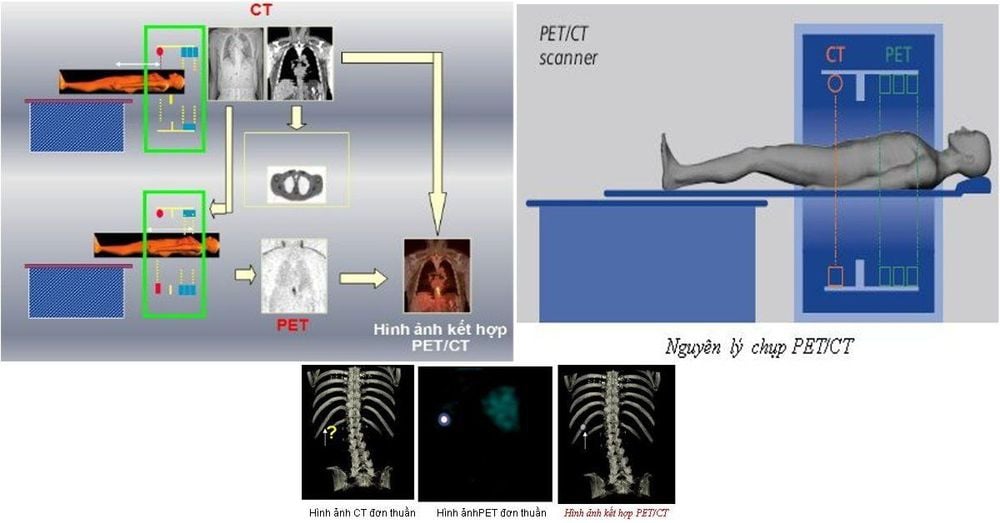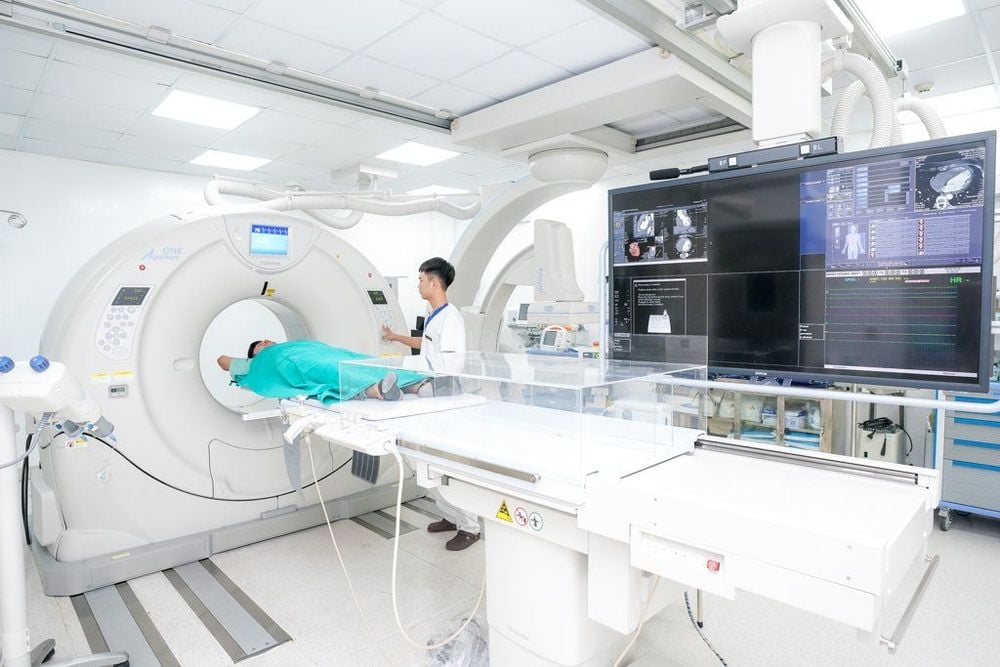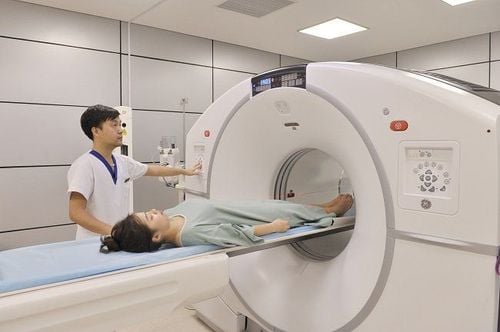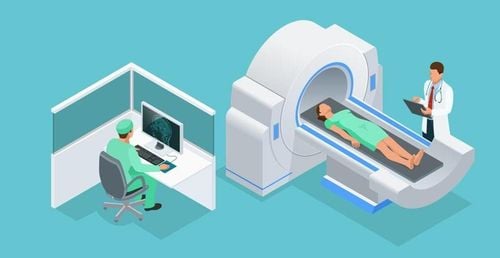This is an automatically translated article.
The article is professionally consulted by Master, Doctor Nguyen Quang Duc - Doctor of Nuclear Medicine - Department of Diagnostic Imaging and Nuclear Medicine - Vinmec Times City International General Hospital.Since the 2000s, Hybrid imaging PET/CT has played an outstanding role in medical diagnosis, especially having diagnostic value in cancer, cardiovascular and neurological diseases.
For some types of cancer, PET/CT is a tool to help diagnose cancer and determine the stage of the disease. Determining the exact condition and stage of the disease helps you and your doctor choose the best treatment. This also helps doctors predict the patient's chances of recovery.
1. How is a PET/CT scan different from a CT scan?
Computed Tomography was born in 1972 by British physicist Godfrey Hounsfield. This technique allows doctors to visualize detailed anatomical structures of organs and tissues inside the body.Unlike structural imaging methods, PET captures metabolic images, allowing the physician to evaluate both qualitatively and quantitatively the biochemical processes down to the molecular level through radiopharmaceuticals. marked radiation.
The combination of PET and CT on the same machine system and in the same recording gives a hybrid image containing full data of the anatomical structure as well as the metabolism of each tissue and organ in the body, provide sufficient information for doctors in diagnosing and assessing the patient's medical condition.
In current clinical practice, over 90% of cases are indicated for PET/CT scan in cancer diseases, suspected cancer to distinguish benign and malignant lesions, find primary lesions, distant metastases or paraneoplastic syndromes. In addition, PET/CT is also used in the diagnosis of neurological, cardiovascular, and infectious diseases.
In addition to determining whether a tumor is benign or malignant, a PET/CT scan can help the doctor:
● Detect the primary lesion;
Assess the stage of the disease;
● Monitor and evaluate the response of cancer treatment;
● Determine the right location to perform the biopsy;
Plan for radiation therapy.
2. How is the PET/CT scan performed?
Before your PET-CT scan, you'll be given a small injection of a radioactive sugar called fluorodeoxyglucose-18, also known as FGD-18, radioactive glucose, or a tracer. The cells in the patient's body will absorb the sugar. Sites that use more energy absorb more sugar. Cancer cells tend to use more energy than healthy cells. A PET scan shows where the radioactive tracer is in the body.A CT scan will show anatomical structures from different angles. You may be given an injection of contrast material before the CT scan, which increases the resolution of the images for a better assessment of certain organs. Finally, a computer with an image processing algorithm will combine the PET and CT images. The doctor receives detailed 3-D results, helping to identify abnormalities in the body, including metabolic and structural images, and anatomical location of the tumor.

3. Is PET/CT scan safe?
The benefits of these diagnostic methods often outweigh the risks. During this procedure, you will be exposed to a small amount of radioactive material. In such amounts, the radioactive material is shown to be harmless.Doctors can perform PET/CT scans with less radiation or limit the areas that need to be scanned. You will need to tell your doctor about information, such as the number of times you have had an imaging test, the method it was performed, your pregnancy status or suspicion that you are pregnant.
This information can help the doctor decide what other imaging tests should be done to reduce the risk. If you're concerned about radiation exposure, talk to your doctor, and see if you can get another test that uses less radiation.
4. What to prepare before PET/CT scan?
The technician will perform the PET/CT imaging process. After examining the image quality, the nuclear medicine specialist will rely on the image data to provide the results.PET/CT scans can be done in hospitals or centers that perform imaging tests. Before the PET/CT scan, the technician will guide you to prepare carefully to avoid affecting the results, including:
● Eating: The patient is asked to fast for 4 hours before the imaging. .
● Your medications and health history: You should consult with your doctor about whether you can take medications or supplements on the day of the recording. Also, tell your doctor if you have diabetes or some other health problem. Specifically, diabetes can alter test results, and radioactive tracer can impact your blood sugar. If you are breast-feeding or may become pregnant, you should inform your doctor for appropriate advice and indications.

● Things you should avoid: Do not choose excessive activities such as jogging or weightlifting 24 hours before shooting. Exercise can make the results less accurate.
● You should wear loose, comfortable clothing without zippers or metal buttons. You will need to remove any clothing with metal as metal can interfere with the shoot, such as belts, earrings, shirts with buttons or zippers, bras, and glasses. You may wear a hospital gown. You will be asked not to wear any jewelry during the PET/CT scan, so it's best to leave them at home on the day of the scan.
● Insurance, costs, and patient consent: If you are concerned about the cost of a PET-CT scan, you should find out what insurance plans you have for coverage before proceeding. take a shot. In addition, the medical staff will ask you to sign a consent form to perform the test. It clearly outlines the benefits and risks of this procedure.
5. PET/CT . Scanning Process
The technician will put the radiopharmaceuticals into your body by intravenous injection.After injecting this substance, you must limit your movements and avoid activities, you can sit in a chair or lie down in bed comfortably. Movement or movement can cause radiopharmaceuticals to be trapped in the muscles, reducing image quality. It takes about 30 to 90 minutes for the radioactive material to reach the parts of the body that need to be scanned.
In some cases, the patient needs an injection of contrast material that can cause allergic reactions or side effects. Most reactions are mild, such as causing a rash or itching. Very rare cases of serious allergic reactions. However, if you have a more serious reaction, such as difficulty breathing, you need to tell your healthcare provider right away. Before starting this procedure, your doctor will ask you to urinate to empty your bladder.
When performing, you will be instructed to lie on the table with positions such as lying on your back, side or stomach, depending on the part to be examined. In some cases, a PET/CT scan is used to plan radiation therapy to treat cancer.
The staff will make you feel as comfortable as possible. You will need to lie still during the test. You may also need to keep your arms overhead.
Staff can also raise or lower the table during scanning. This helps them get images from different angles.
Total PET/CT scan time from preparation to finish usually takes 1 to 3 hours. Recording time on the device takes about 30 minutes. If the scanner scans a large area of the body, the examination may take longer. Staff will let you know how long it takes.

After the PET/CT scan, you can go about your normal activities. The technician will remind you to drink more water to increase the elimination of radioactive material before you leave.
Before having a PET/CT scan, there are a few questions you can ask your doctor:
● Where will I get the PET/CT scan?
● How long does a PET/CT scan take?
● What are the benefits and risks?
What can I eat or drink before the shoot? What about my usual medication?
● What should I avoid?
● When will I receive my test results?
● Who will tell me the results, and how?
● Do I need other tests?
Currently, Vinmec International General Hospital has become a leading prestigious address in disease screening with modern techniques, proud to be the first private hospital in Vietnam to deploy this technique. Modern and accurate diagnosis with the most modern 128-sequence PET/CT system in Southeast Asia, for accurate images and short imaging time, the team of doctors are leading experts with high expertise and rich experience. Experience creates trust for customers when experiencing medical examination and treatment services at Vinmec.
German doctor has more than 12 years of experience in the field of Diagnostic Imaging. Recently, the Doctor has been assigned to specialize in the field of Nuclear Medicine. Currently, the doctor is studying for an intensive course in Nuclear Medicine at Stanford Hospital, USA.
Please dial HOTLINE for more information or register for an appointment HERE. Download MyVinmec app to make appointments faster and to manage your bookings easily.
Reference source: . cancer.ne













